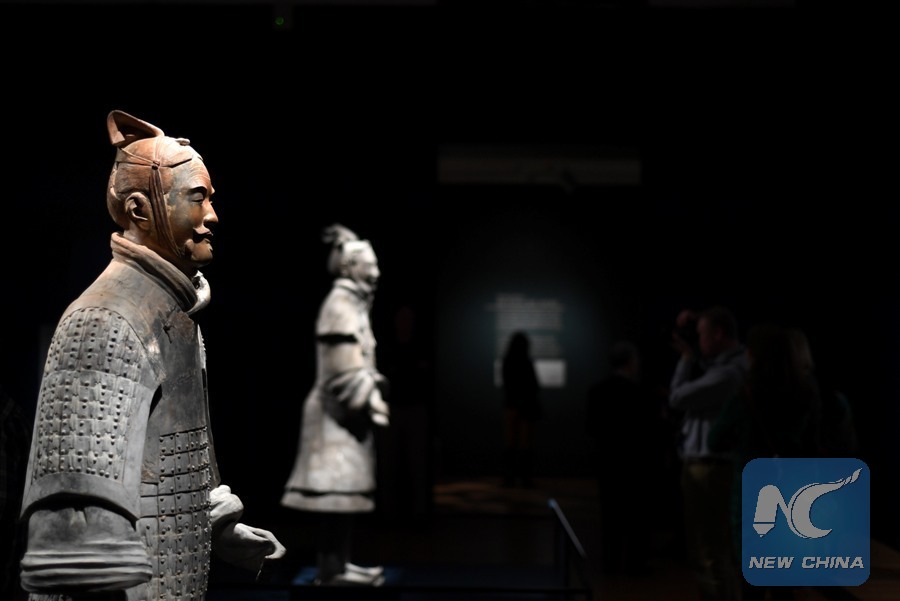
People view Terracotta Warriors during a press preview at the Virginia Museum of Fine Arts (VMFA) in Richmond, Virginia, the United States, on Nov. 15, 2017. (Xinhua/Yin Bogu)
RICHMOND, the United States, Nov. 16 (Xinhua) -- A set of China's Terracotta Warriors have marched into historic Richmond, capital of U.S. state of Virginia, as local museum-goers, impressed by its delicacy and artistry, are given an extraordinary taste of the Chinese history.
Ten life-size figures, including warriors and a cavalry horse, that protected the tomb of Qin Shihuang, China's First Emperor, have been displayed this week at the Virginia Museum of Fine Arts (VMFA), as part of Chinese-themed exhibition Terracotta Army: Legacy of the First Emperor of China.
"The Terracotta Army is one of the most important archaeological discoveries of the 20th century," VMFA Director Alex Nyerges told Xinhua.
The exhibition, according to the museum, showcases over 130 works of art, drawn from the collections of 14 art museums and archaeological institutes across northwest China's Shaanxi, including more than 40 objects never shown before in the United States.
"From the featured objects, our audience will learn about the First Emperor's political and cultural innovation and legacy, as well as gain a better understanding about ancient Chinese cultural history as part of world civilization," said Nyerges.
The terracotta figures displayed at the VMFA were among the estimated 8,000 life-size sculptures of warriors, chariots, and horses that were discovered in 1974 by local farmers in Lintong District, outside Xi'an in Shaanxi province.
The grand mausoleum complex was listed by the UNESCO as a World Heritage Site in 1987.
Nyerges said the exhibition is the first of its kind organized by the VMFA that is devoted to the art and archaeology of ancient China in the museum's 80-year history.
Lasting until March next year, the three-section exhibition will take visitors on a journey to explore how the Qin state developed into an empire under Ying Zheng (259-210 BC), who unified China and declared himself Qin Shihuang, or the First Emperor of Qin, and his quest for immortality.
Besides, the exhibition features arms and armor, horse and chariot fittings, ritual bronze vessels, works in gold and silver, jade ornaments, precious jewelry, ceramics, and architectural components that were excavated from the Emperor Qin Shihuang's mausoleum, as well as aristocratic, commoner, and nomadic tombs.
Li Jian, one of the exhibition's curators, told Xinhua that these objects, dating from the Zhou dynasty (1046-256 BC) through the Qin dynasty (221-206 BC), reflect the complex history, myths and burial customs of ancient China and explore Emperor Qin Shihuang's profound influence on Chinese history, art, and culture.
"The legacy of the First Emperor is enormous, including administration, law, language, art, architecture, interstate roadways, and the Great Wall," Li said. "Our exhibition is organized to bring our audience a better understanding of Qin history, and ancient Chinese art and archaeology."
"Going to a museum is the very best way for people to learn other countries' culture and history," Nyerges said.
"The Qin Dynasty is so important that it allowed China to become what it is today," the director stressed. "It would be the greatest chapter for American people to start learning the Chinese history."
Looking at a 2,200-year-old armor set, Lynn Johnson, a local visitor at the exhibition, told Xinhua that she was amazed by the incredible display of the Terracotta Army at the exhibition.
"Just imagine what it feels like to stand in front of thousands of sculptures inside Emperor Qin Shihuang's mausoleum complex," she said. "I would love to go to China and see them myself someday in the future."

